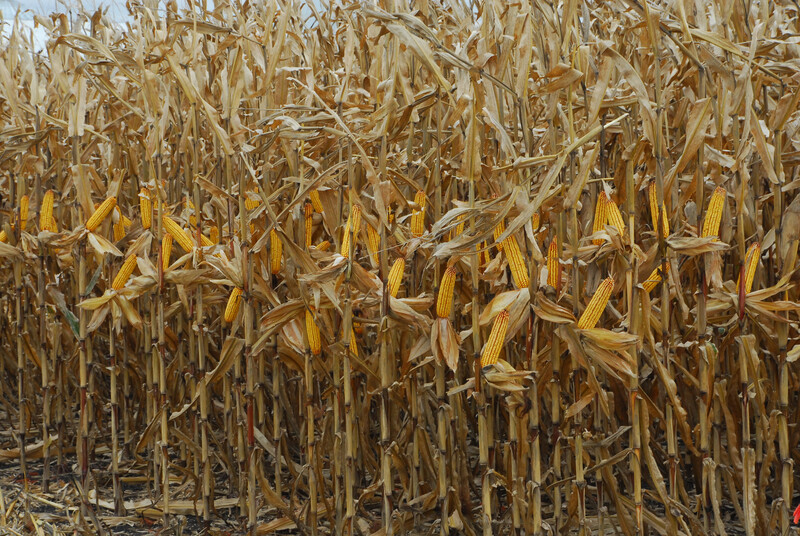
(The opinions expressed here are those of the author, a market analyst for Reuters.)
By Karen Braun
FORT COLLINS, Colo., Sept 29 (Reuters) - Industry analysts are predicting a highly unlikely scenario when it comes to Sept. 1 supplies of U.S. corn and soybeans, which could set up a surprise when the U.S. Department of Agriculture publishes those numbers on Wednesday.
The trade expects both Sept. 1 corn and soybean inventories, effectively ending stocks for the 2019-20 marketing year, to land within 0.2% of what USDA projected earlier this month. In the last 20 years, that has happened once for corn and never for soybeans.
Additionally, there are some influential demand items like feed and residual use that could skew supply levels for both crops, and they deserve a closer look before USDA’s report set for Wednesday at noon EDT (1600 GMT).
The average guess for Sept. 1 corn stocks is 2.25 billion bushels, which would be up 1% on the year and a three-year high. The soybean estimate is 576 million bushels, the second-largest ever but down 37% from the year-ago record.
Chicago corn and soybean futures uncharacteristically rallied through August and mid-September from multiyear lows earlier in 2020, sparked by U.S. harvest concerns and strong export demand. Although prices have come well off their highs, they remain elevated for the time of year, particularly for soybeans.
Speculators have built large net-long positions in both soybeans and corn, meaning that funds are well-positioned for a selloff if sufficiently heavy supplies are revealed on Wednesday.
In the last five years, the market underestimated Sept. 1 corn and soybean stocks only once, in 2018. Futures fell on that day, but otherwise, they have had positive reactions on recent end-of-September report days.
CORN
Back in January, USDA made an unusual revision to the 2018-19 U.S. corn ending stocks that could trickle through to Wednesday’s figure.
In short, the agency decided that implied feed and residual (F+R) corn use in 2018-19 was too high given the animal numbers during the year. In January, the prior year's F+R was reduced by 186 million bushels from what market participants assumed was final back in October.
USDA simultaneously pumped up 2019-20 F+R by 250 million bushels, a very large monthly increase, especially considering the relatively light change in expected supply levels. USDA’s latest estimate of 2019-20 F+R use is slightly higher than in January at 5.6 billion bushels, which would be a 12-year high and up 3% on the year.
Recent history suggests that USDA tends to overestimate F+R throughout the marketing year.
By the Sept. 1 corn stock prediction, analysts peg June-August corn use at a three-year low, down just 0.2% from the previous year. Ethanol production fell around 16% on the year during that period and exports rose 55%, though exports account for just 15% of domestic corn use.
USDA often adjusts the prior year’s soybean crop at the end of September based on the Sept. 1 supply data, but that could also be on tap this time for corn. The average trade guess for 2019 U.S. corn production is 13.607 billion bushels, down 10 million from the latest figure.
SOYBEANS
One factor that could come into play on Wednesday is USDA’s negative projection for 2019-20 residual soybean demand, which sits at minus 45 million bushels. There have been only three times within the last 20 years when residual demand in the old-crop year was negative heading into the Sept. 1 stocks report: 2013-14, 2007-08 and 2003-04.
In all three cases, final residual demand ended up positive, which was reflected in the October supply and demand report. Analysts had underestimated Sept. 1 soybean stocks in at least the two most recent cases.
The magnitude of the prior harvest revision has often played a large role in the trade’s past soybean stock misses. USDA has made September revisions to the prior year’s soybean harvest in 18 of the last 20 years, increasing output 10 times and reducing it eight times.
On average, analysts see 2019 soybean production at 3.575 billion bushels, up 23 million bushels from USDA’s latest figure. Directionally, that is a good bet because large crops tend to shrink and smaller ones like 2019 usually get revised upward.
It is possible for the potential boost to last year’s crop combined with the negative residual to create a more supply-heavy situation for soybeans than traders expect.
Based on the trade estimates for Sept. 1 soybean stocks, fourth-quarter use would be the second-largest ever but down 7% from last year’s high. June-August exports were down around 26% on the year while soybean crush during that period was up about 4%, according to figures from the National Oilseed Processors Association.
(Editing by Matthew Lewis)








 User Center
User Center My Training Class
My Training Class Feedback
Feedback












Comments
Something to say?
Log in or Sign up for free